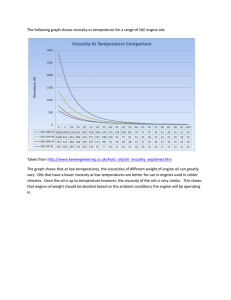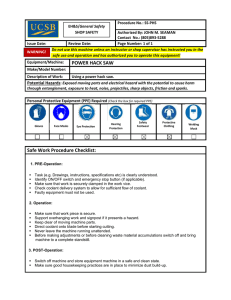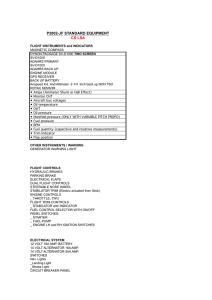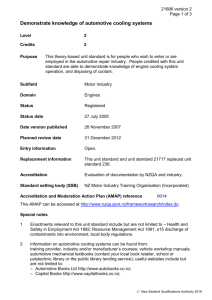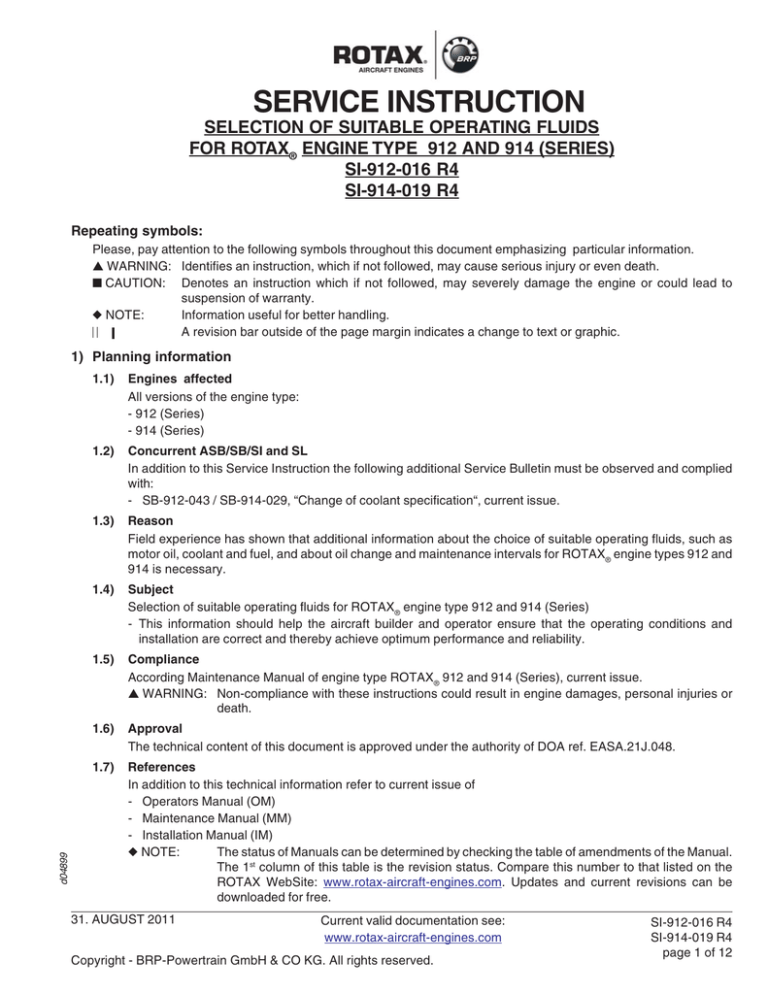
SERVICE INSTRUCTION
SELECTION OF SUITABLE OPERATING FLUIDS
FOR ROTAX® ENGINE TYPE 912 AND 914 (SERIES)
SI-912-016 R4
SI-914-019 R4
Repeating symbols:
Please, pay attention to the following symbols throughout this document emphasizing particular information.
▲ WARNING: Identifies an instruction, which if not followed, may cause serious injury or even death.
■ CAUTION: Denotes an instruction which if not followed, may severely damage the engine or could lead to
suspension of warranty.
◆ NOTE:
Information useful for better handling.
A revision bar outside of the page margin indicates a change to text or graphic.
d04899
1) Planning information
1.1)
Engines affected
All versions of the engine type:
- 912 (Series)
- 914 (Series)
1.2)
Concurrent ASB/SB/SI and SL
In addition to this Service Instruction the following additional Service Bulletin must be observed and complied
with:
- SB-912-043 / SB-914-029, “Change of coolant specification“, current issue.
1.3)
Reason
Field experience has shown that additional information about the choice of suitable operating fluids, such as
motor oil, coolant and fuel, and about oil change and maintenance intervals for ROTAX® engine types 912 and
914 is necessary.
1.4)
Subject
Selection of suitable operating fluids for ROTAX® engine type 912 and 914 (Series)
- This information should help the aircraft builder and operator ensure that the operating conditions and
installation are correct and thereby achieve optimum performance and reliability.
1.5)
Compliance
According Maintenance Manual of engine type ROTAX® 912 and 914 (Series), current issue.
▲ WARNING: Non-compliance with these instructions could result in engine damages, personal injuries or
death.
1.6)
Approval
The technical content of this document is approved under the authority of DOA ref. EASA.21J.048.
1.7)
References
In addition to this technical information refer to current issue of
- Operators Manual (OM)
- Maintenance Manual (MM)
- Installation Manual (IM)
◆ NOTE:
The status of Manuals can be determined by checking the table of amendments of the Manual.
The 1st column of this table is the revision status. Compare this number to that listed on the
ROTAX WebSite: www.rotax-aircraft-engines.com. Updates and current revisions can be
downloaded for free.
31. AUGUST 2011
Current valid documentation see:
www.rotax-aircraft-engines.com
Copyright - BRP-Powertrain GmbH & CO KG. All rights reserved.
SI-912-016 R4
SI-914-019 R4
page 1 of 12
2) Material Information
2.1)
Material - cost and availability
None.
3) Lubricant
3.1)
General
Foreign particles formed during combustion are suspended in the motor oil. Together with oil components that
are not sufficiently resistant to heat, these foreign particles can cause parts such as pistons, piston rings, exhaust
valves, etc., to seize and lead to problems.
On turbocharged engines, failing to ensure an adequate cool-down period prior to shut-off may lead to particle
deposits and cause damage to bearings and seals. Hard oil residues can obstruct parts of the oil system and
lead to damage.
- In addition to insufficient cool-down periods, the use of unsuitable oils and not obeying oil change intervals can
especially cause such damage.
- Long-term operation with an engine that is too cold and/or operating too long with an overly rich fuel mixture
can cause water and fuel contamination in the oil, reducing its lubrication capacity.
- Furthermore, long down times with oil that contains water and contaminants can cause corrosion damage,
especially on the bearings, with serious consequential damage.
The criteria for correct motor oil selection are:
- Correct oil viscosity for cold starts and sufficient oil pressure at high temperatures.
- Good gear wear protection.
- Avoidance of clutch slipping due to use of additives.
- Insufficient oil flow capability so that too much volume remains in the engine, leading to low oil level in the
external oil tank. This can only be detected during testing with an oil level indicator installed on the oil tank.
- Ability to withstand combustion products containing lead, which enter the oil during AVGAS operation.
- High oil temperature durability. This is especially important for the turbo engine due to the risk of oil carbon buildup on the bearing and sealing seats of the turbocharger. The oil carbon build-up (coking) can also flake off and
block/restrict the oil return passage.
Conclusions
- If possible, operate the listed engine types using unleaded or low-lead fuel. (AVAGS 100 LL is not considered
low leaded in this context.)
- Use the motor oils, tested and released by BRP-Powertrain or which are recommended by the local, authorized
distributor, according to sections 3.2 and 3.3 of this Service Instruction.
- Use only oil with API classification „SG“ or higher!
- Due to high stresses in the reduction gears, oils with gear additives such as good quality 4 stroke motorcycle
oils are highly recommended.
- Because of the incorporated friction clutch, oils with friction modifier additives are unsuitable because this could
result in clutch slipping during standard operation.
- Heavy duty, semi- or fully synthetic (depending on fuel type used) brand name oils offer many advantages and
are generally the best choice.
- Avoid oils designed strictly for use in Diesel engines. These may not be suitable due to insufficient high
temperature properties and additives that may affect the operation of the slipper clutch in the gear box.
- In case of severe operating conditions (i.e., flight school, towing, near-idle operation over a long period, overuse of carburetor preheating, etc.) the time between maintenance intervals must be generally shorter and in
particular, the frequency of oil changes must be increased regardless of the type of fuel mainly used (MOGAS
or AVGAS). Refer to current Maintenance Manual for more information and instructions.
- On turbocharged engines, always conduct a cool-down run before shutting down in accordance with the
relevant Operators Manual.
- Careful attention to engine operation tips (see section 6).
31. AUGUST 2011
Copyright - BRP-Powertrain GmbH & CO KG. All rights reserved.
SI-912-016 R4
SI-914-019 R4
page 2 of 12
3.2)
Operation with unleaded and low-lead fuel (less than 0.1 g/liter lead content)
■ CAUTION: When operating primarily on unleaded fuels or MOGAS, the maintenance intervals remain
unchanged from the published maintenance schedule found in the currently valid Maintenance
Manual for the engine type.
In case of severe operating conditions, the time between maintenance intervals must be
generally shorter, and in particular, the frequency of oil changes must be increased regardless
of the type of fuel mainly used (MOGAS or AVGAS).
Use the following oils and observe the oil specification indicated:
Motor oils tested and released from BRP-Powertrain (for use with unleaded fuel or MOGAS)
09464
Marke /
brand
SHELL®
Bezeichnung / description
AeroShell Sport Plus 4
31. AUGUST 2011
Copyright - BRP-Powertrain GmbH & CO KG. All rights reserved.
Code 1) /
code 1)
Spezifikation /
specification
Viskosität * /
viscosity
API SL
SAE 10 W-40
2
SI-912-016 R4
SI-914-019 R4
page 3 of 12
Motor oils recommended from the authorized distributors (not tested from BRP-Powertrain)
(for use with unleaded fuel or MOGAS)
◆ NOTE:
The following list is based on the experiences and local recommendation from the authorized
distributors. Oil brands, with same designation, may vary from one to the other region. Please
contact the local distributor for (the recommendation for) the corresponding region.
09465
M arke /
brand
EVVA®
EVVA®
M OB IL ®
M OB IL ®
M OB IL ®
M OB IL ®
M OB IL ®
S HE LL ®
S HE LL ®
S HE LL ®
S HE LL ®
S k y driv e ®
Y ac c o ®
Bez eichnung / description
E V V A C52 A irm ax
E V V A M ehrbereic hs öl C52 / m ultigrade oil C52
M obil 1
M obil 1
M obil 1 Rac ing 4T / M X 4T
M obil 1 V -Twin
M obil 1 Clean 7500
A dv anc e V S X 4
A dv anc e V S X 4
A dv anc e Ultra 4
Form ula S hell S y nthetic B lend
S k y driv e A erolube 10W 40 oil
A ero A V X 500 4T
S pez ifikation /
specification
V iskosität * /
viscosity
A P I S J /CF
A P I S J /CF
A P I S J /CF
A P I S J /CF
A P I S G/CF
A P I S G/CF
A P I S M /S L
API SG
API SG
API SJ
API SL
API SL
API SL
S A E 10 W -40
S A E 15 W -50
S A E 5 W -30
S A E 15 W -50
S A E 10 W -40
S A E 20 W -50
S A E 10 W -30
S A E 10 W -40
S A E 15 W -50
S A E 10 W -40
S A E 10 W -30
S A E 10 W -40
S A E 10 W -40
Code
1)
code
/
1)
3
3
5
5
1
1
4
3
3
1
4
2
2
1)
property code
1 Full-synthetic motorcycle oil with gear additives. Highly recommended for occasionally high oil temperature
operation (higher than 120 °C / 250 °F) using only unleaded fuels.
2 Semi-synthetic aviation oils with gear additives. Highly recommended for normal (lower than 120 °C /
250 °F) and occasionally high oil temperature (higher than 120 °C / 248 °F) operation using leaded or unleaded
fuels.
3 Semi-synthetic motorcycle oils with gear additives. Highly recommended for normal (lower than 120 °C /
250 °F) and occasionally high oil temperature (higher than 120 °C / 248 °F) operation using leaded or unleaded
fuels.
4 Semi-synthetic oil. Recommended for normal (lower than 120 °C / 248 °F) and occasionally high oil
temperature (higher than 120 °C / 250 °F) operation using leaded or unleaded fuels.
5 Full-synthetic oil: Recommended for high oil temperature operation (higher than 120 °C / 248 °F) using only
unleaded fuels.
* The viscosity column is only a guideline. Substituting other than that shown is acceptable.
Example: Formula Shell Synthetic Blend SAE 5W-30 is a substitute for 10W-30. The guidelines given here
must, however, be obeyed in all cases, using only those oils with which there have already been good operating
experiences on ROTAX® engine types 912 and 914 (series).
◆ NOTE:
The coefficient of viscosity indicates the tendency of oil to flow but it is not necessarily a quality
code. Country specific deviations of the viscosity are possible.
31. AUGUST 2011
Copyright - BRP-Powertrain GmbH & CO KG. All rights reserved.
SI-912-016 R4
SI-914-019 R4
page 4 of 12
3.3)
Operation with leaded AVGAS fuels
If the engine is mainly operated with leaded AVGAS fuels, the following maintenance operations are necessary
in addition by latest after every 50 operating hours:
- change of oil filter
- change of engine oil
- oil level checks, etc., according to the most recent Maintenance Manual.
In addition, compliance with the following operating conditions is required:
■ CAUTION: The engine is considered to be operated mainly on leaded AVGAS, when run for more than 30%
of engine operating time on leaded AVGAS fuel.
◆ NOTE:
When operating primarily on leaded AVGAS fuel, we recommend to make a change of engine
oil every 25 operating hours.
More frequent oil changes will assure timely removal of residues and oil sludge thus avoiding increased wear
or operating troubles.
Use the following oils and observe the oil specification indicated:
Motor oils tested and released from BRP-Powertrain (for use with leaded AVGAS)
09464
Marke /
brand
SHELL®
Bezeichnung / description
AeroShell Sport Plus 4
31. AUGUST 2011
Copyright - BRP-Powertrain GmbH & CO KG. All rights reserved.
Spezifikation /
specification
Viskosität * /
viscosity
API SL
SAE 10 W-40
Code 1) /
code 1)
2
SI-912-016 R4
SI-914-019 R4
page 5 of 12
Motor oils recommended from the authorized distributors (not tested from BRP-Powertrain)
(for use with leaded AVGAS)
◆ NOTE:
The following list is based on the experiences and local recommendation from the authorized
distributors. Oil brand, with same designation, may vary from one to the other region. Please
contact the local distributor for (the recommendation for) its region.
M arke /
b ran d
/
V isko sität * /
visco sity
A P I S J /C F
S A E 10 W -40
3
E V V A M ehrbereic hs öl C 52 / m ultigrade oil C 52
A P I S J /C F
S A E 15 W -50
3
M obil 1 C lean 7500
A P I S M /S L
S A E 10 W -30
4
S H E LL ®
S k y driv e A erolube 10W 40 oil
A dv anc e V S X 4
API SL
API SG
S A E 10 W -40
S A E 10 W -40
2
3
S H E LL ®
S H E LL ®
S H E LL ®
V alv oline ®
Y A CCO ®
F orm ula S hell S y nthetic B lend
F orm ula S hell
F orm ula S hell
D uraB lend S y nthetic
A ero A V X 500 4T
API
API
API
API
API
SAE
SAE
SAE
SAE
SAE
4
5
5
4
2
EVVA®
EVVA
®
M O B IL ®
S k y driv e ®
1)
E V V A C 52 A irm ax
property code
SL
SJ
SJ
SJ
SL
10
10
20
10
10
W -30
W -30
W -50
W -40
W -40
Code
1)
S p ez ifikatio n /
sp ecificatio n
B ez eich n u n g / d escrip tio n
co d e
1)
09466
2 Semi-synthetic aviation oils with gear additives. Highly recommended for normal (lower than 120 °C /
248 °F) and occasionally high oil temperature (higher than 120 °C / 248 °F) operation using leaded or unleaded
fuels.
3 Semi-synthetic motorcycle oils with gear additives. Highly recommended for normal (lower than 120 °C /
248 °F) and occasionally high oil temperature (higher than 120 °C / 248 °F) operation using leaded or unleaded
fuels.
4 Semi-synthetic oil. Recommended for normal (lower than 120 °C / 248 °F) and occasionally high oil
temperature (higher than 120 °C / 248 °F) operation using leaded or unleaded fuels.
5 Petroleum based oil. Recommended for use only when oil temperatures remain below 120 °C (248 °F) and
when using leaded fuels.
* The viscosity column is only a guideline. Substituting other than that shown is acceptable providing all
temperature limitations are respected.
Example: Formula Shell Synthetic Blend SAE 5W-30 is a substitute for 10W-30. The guidelines given here
must, however, be obeyed in all cases, using only those oils with which there have already been good operating
experiences on ROTAX® engine types 912 and 914 (series).
◆ NOTE:
The coefficient of viscosity indicates the tendency of oil to flow but it is not necessarily a quality
code. Country specific deviations of the viscosity are possible.
31. AUGUST 2011
Copyright - BRP-Powertrain GmbH & CO KG. All rights reserved.
SI-912-016 R4
SI-914-019 R4
page 6 of 12
3.4)
Motor oils not suitable for engine types 912 / 914 Series
Experience has shown that only some oils are suitable for use in ROTAX® engine types 912/914 and careful
selection is advised following the recommendations in this Service Instruction.
BRP-Powertrain is aware of formulation changes to some oils previously recommended for use in this Service
Instruction. As a result, BRP-Powertrain no longer recommends the following oils and these should not be used
anymore.
Marke /
brand
Bezeichnung / description
Castrol®
Castrol Power 1
Castrol®
GPS
MOTUL
®
5100 Synthetic Blend
31. AUGUST 2011
Copyright - BRP-Powertrain GmbH & CO KG. All rights reserved.
Spezifikation /
specification
API SJ
API SG / CD
API SJ
SI-912-016 R4
SI-914-019 R4
page 7 of 12
4) Coolant
4.1)
General
All engine types 912/914 have liquid cooled cylinder heads and ram air cooled cylinders. The function of the
coolant is to protect the cylinder heads from over-temperature by means of heat dissipation. Protection against
corrosion of the engine components and freezing of the coolant is achieved with appropriate additives.
In principle, 2 different types of coolant are permitted:
- Conventional coolant based on ethylene glycol with 50% water content
- Waterless coolant based on propylene glycol
4.2)
Conventional coolant
Conventional coolant (with about 50% water content) has a specific thermal capacity that is higher than waterless
coolant. It gives excellent corrosion protection, especially for aluminum, and protection against freezing.
◆ NOTE:
For exact monitoring of the coolant temperature, a limit has been set. This is necessary because
standard coolant based on ethylene glycol such as BASF Glysantin in a 50/50 proportion mixture
can boil at a temperature as low as 120 °C (248 °F). Refer to the current Installation Manual for
more information and instructions.
■ CAUTION: The certification and determination of the correct coolant type must be conducted by the aircraft
manufacturer. As each aircraft type has different characteristics, testing must be done to
determine the most suitable coolant and instrumentation for each aircraft type.
◆ NOTE:
Coolant should be a low silicate and nitrite free formula. Follow coolant manufacturer directions
regarding mixture percentages etc.
From the authorized distributors recommended coolants with a mixture of 50% antifreeze and 50%
water. (not tested from BRP-Powertrain)
◆ NOTE:
The following list is based on the experiences and local recommendation from the authorized
distributors. Coolant brands, with same designation, may vary from one to the other region.
Please contact the local distributor for a recommendation.
M arke / b ran d
BA SF®
B ez eich n u n g / d escrip tio n
G ly s antin P rotec t P lus /G 48
®
CA S T RO L®
A ntifreez e A ll-C lim ate
A ntifreez e A nti-B oil
OMV®
O M V C oolant P lus
P E T RO L®
P RE S TO NE ®
A ntifreez e C onc entrate / A ntifreez e G 11
D E X -C O O L ex tended life
P RE S TO NE ®
50/50 preluded D E X -C O O L ex tended life
CA S TRO L
®
D E X -C O O L
®
S H E LL
TE X A CO ®
A ntifreez e C onc entrate
H av oline E x tended Life A ntifreez e /
V E LV A N A ®
F R ID E X G 49
Y A CCO ®
LR -35
S H E LL
08758
31. AUGUST 2011
Copyright - BRP-Powertrain GmbH & CO KG. All rights reserved.
SI-912-016 R4
SI-914-019 R4
page 8 of 12
4.3)
Waterless coolant
Waterless coolant has advantages to prevent boiling of the cooling system because of its high boiling point.
However, the specific thermal capacity is lower than with conventional coolant resulting in slightly higher running
temperatures.
The cooling system of ROTAX® engine types 912/914 is designed for operation with waterless coolant and thus
must not be modified, i.e., drainage or ventilation holes must not be closed.
◆ NOTE:
With waterless coolant based on propylene glycol such as EVANS NPG+, it is sufficient to
monitor the cylinder head temperature since the boiling point is very high.
■ CAUTION: The certification and determination of the correct coolant type must be conducted by the aircraft
manufacturer. As each aircraft type has different characteristics, testing must be done to
determine the most suitable coolant and instrumentation for each aircraft type.
Recommended coolant (100% concentrate)
M a rk e /
b ra n d
B e z e ic h n u n g / d e sc rip ti o n
E V A NS ®
NP G+
®
NP GR
E V A NS
07181
■ CAUTION: EVANS NPGR contraction point is approx. -23 °C (-10 °F) . It will not freeze and expand like
conventional coolant. Do not use if conditions expose the engine to non-operational temperatures
below -23 °C (-10 °F).
4.3.1) Warnings for operating with waterless coolant
- Water or coolant containing water must never be added to the cooling system!
- The max. water content must not exceed 3.6 %; it can be tested using a Brix refractometer.
- Any water present in the cooling system is separated out as vapor. This can cause the cooling system
to fail due to insufficient coolant quantity.
- If EVANS NPG+/NPGR is not available locally for servicing the cooling system, a conventional coolant
based on pure 100% ethylene glycol can be used temporarily. However, the coolant must be replaced
again with EVANS NPG+/NPGR within the next 15 days.
■ CAUTION: As some conventional coolants are available in a pre-mixed formula (water added) be
sure you only add 100% pure ethylene glycol if EVANS NPG+/NPGR is not available.
■ CAUTION: The above warnings are taken from the manufacturer’s user manual, however the
original text and description in the user manual is binding.
31. AUGUST 2011
Copyright - BRP-Powertrain GmbH & CO KG. All rights reserved.
SI-912-016 R4
SI-914-019 R4
page 9 of 12
5) Fuel
For ROTAX® aircraft engines different fuel types are available. See Operators Manual of the relevant engine type and/
or the table in chapter 5.3.
5.1)
Automotive fuels
In addition to AVGAS various automotive fuel types with different quality are available. Due to various
environmental, economic and political reasons a number of fuel types with different amount of ethanol blend is
available. Therefore the maximum amount of ethanol blend is defined as follows:
5.1.1) E10 (Unleaded gasoline blended with 10 % ethanol)
In addition to AVGAS and unleaded automotive fuel (Mogas) the ROTAX® 912/914 series of engines are
now approved for use with E10. Fuels that contain more than 10% ethanol blend have not been tested
by BRP-Powertrain and are not permitted for use.
5.1.2) Suitability of fuel system components of airframe
BRP-Powertrain urges owners to confirm with their airframe manufacturer that ethanol blended fuels of
up to 10% (E10) are compatible with all fuel system components.
It is the responsibility of the aircraft manufacturer to test their fuel system components and supply any
further information on techniques, procedures and limitations of using ethanol blended fuel.
BRP-Powertrain recommends that aircraft manufacturer and owner/operators read the following:
- FAA Advisory Circular Letter AC 23.1521-2
- FAA Special Airworthiness Information Bulletin CE-07-06
- EASA Safety Information Bulletin – SIB 2009-02
These contain details regarding the use of ethanol (alcohol) blended fuels and the type certificate
requirements.
It is strongly recommended that also non-certified aircraft also conform to the information given in the
above documents.
5.2)
AVGAS fuel additives
Additives, which aid the scavenging of lead deposits under the names of Decalin® and Alcor TCP®, have not been
tested by BRP-Powertrain . Field experience gained shows that these products have no detrimental effect on
the engine, when used in the recommended manner.
Always follow the additive manufacturers instructions especially with regard to health and safety precautions.
BRP-Powertrain only has field experience with Decalin RunupTMand Alcor TCP® brands. Other similar additives
are not advised as BRP-Powertrain cannot comment on their suitability for the 912/914 engine types.
31. AUGUST 2011
Copyright - BRP-Powertrain GmbH & CO KG. All rights reserved.
SI-912-016 R4
SI-914-019 R4
page 10 of 12
5.3)
Fuel according to local standards
The following fuels can be used.
Usage / Description
912 UL / A / F
Min. RON 90 (min. AKI* 87)
912 ULS / S - 914 UL /F
Min. RON 95 (min. AKI 91)
MOGAS
EN 228 Normal
European
standard
Canadian
standard
Russian
standard
EN 228 Super
EN 228 Super
EN 228 Super plus
EN 228 Super plus
CAN/CGSB-3.5 Qualität 1
CAN/CGSB-3.5 Qualität 3
R 51105-97
R 51866-2002
Regular-91/92
Regular Euro-92
Premium-95
Super-98
US standard
R 51105-97
R 51866-2002
Premium Euro-95
Premium-95
Premium Euro-95
Super Euro-98
Super-98
Super Euro-98
ASTM D4814
ASTM D4814
leaded
AVGAS 100 LL ASTM D910
AVGAS 100 LL
ASTM D910
unleaded
UL91
ASTM D7547
UL91
ASTM D7547
HJELMCO AVGAS
91/96 UL
HJELMCO AVGAS
91/96 UL
HJELMCO AVGAS
91/98 UL
HJELMCO AVGAS
91/98 UL
AVGAS
released brand-name 1)
08827
1)
unleaded, mainly available in the Scandinavian area
* Anti-Knock Index, (RON+MON)/2
AVGAS 100LL places greater stress on the valve seats due to its high lead content and forms increased deposits
in the combustion chamber and lead sediments in the oil system. Thus it should only be used in case of problems
with vapor lock or when other types of gasoline are unavailable.
■ CAUTION: Use only the correct fuel for the specific climate zones.
◆ NOTE:
There is a risk of vapor lock formation if winter fuel is used for summer operation.
31. AUGUST 2011
Copyright - BRP-Powertrain GmbH & CO KG. All rights reserved.
SI-912-016 R4
SI-914-019 R4
page 11 of 12
6) General engine operation requirements and operating tips
1. Keep the motor oil temperature below 120 °C (250 °F) over most of the operating period.
2. Always insure that the oil type used is adequate for climatic conditions and peak engine operating temperatures.
If operational oil temperatures exceed 120 °C (250 °F), use of a mineral or petroleum based oil is not recommended.
3. For turbocharged engines ensure an adequate running cool-down period to prevent deposits by coking of oil.
4. When operating with unleaded fuels or MOGAS and when engine oil temperatures often exceed 120 °C (250 °F)
use of a high quality full synthetic oil is recommended.
5. To avoid formation of condensation water in the motor oil, the oil temperature must rise at least once every
operational day to at least 100 °C (212 °F).
6. When safe and sensible, avoid extended use of carburetor air pre-heating.
7. The type of fuel used, operating conditions, and the demands of the engine mission profile may need to increase
the frequency of oil changes to avoid the excessive build up of lead and other residues in the engine oil. Always
adjust the engine oil change intervals to avoid excessive build up of sludge in the engine oil.
■ CAUTION: Do not use oil additives and observe the operating limits as per the relevant Operators Manual.
Excessive engine vibration, particularly at low idle speeds, can impair the carburetor fuel metering system leading to
a too rich mixture condition. This rich mixture condition can further lead to rough engine operation and excessive carbon
and lead deposits.
7) Summary
▲ WARNING: Non-compliance with these recommendations could result in engine damage, personal injury or death!
Approval of translation to best knowledge and judgment - in any case the original text in the German language and
the metric units (SI-system) are authoritative.
31. AUGUST 2011
Copyright - BRP-Powertrain GmbH & CO KG. All rights reserved.
SI-912-016 R4
SI-914-019 R4
page 12 of 12

